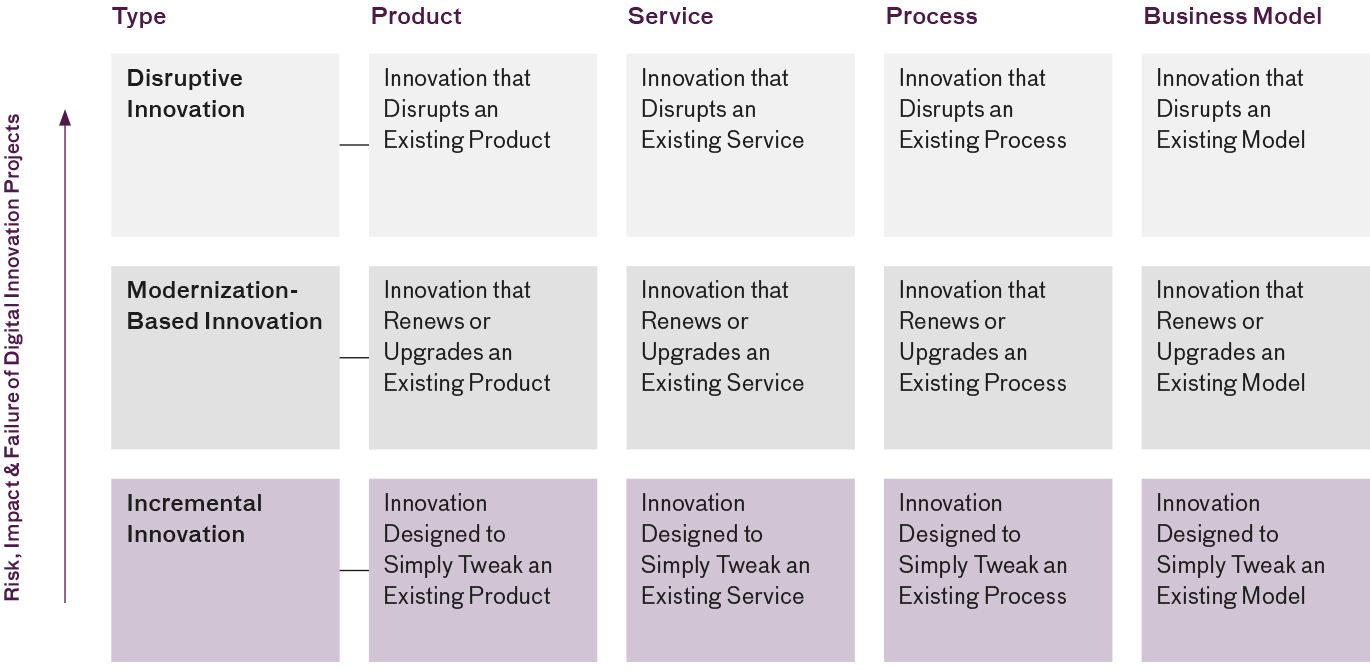
Innovation’s Quiet Truth
All ventures must innovate to remain competitive. However, the harsh reality is that most innovation initiatives fail despite massive investments in methodologies, organizational structures and human capital. Substantive innovation requires far more than inspirational quotes about change and irrelevance, aspirational task forces, dedicated funding and other forms of stagecraft. This paper synthesizes research on why innovation falters and how courageous leaders can try to fix it by disassembling its teams, structures and perhaps, over time, its culture.
Substantive innovation requires far more than inspirational quotes about change and irrelevance, aspirational task forces, dedicated funding and other forms of stagecraft
Innovation Challenges
Innovation is not necessarily a mainstream function. Regardless of the industry, at its essence, it challenges orthodoxy, vested interests, misaligned incentives and entrenched workplace power bases. Not surprisingly, its failure is rooted in widespread human, organizational and workplace culture problems.
People problems include less than perfect innovation leadership capabilities: many executives and program/project managers have little or no innovation experience. Further, the very skills and competencies that advance careers and serve traditional functions well are ill-suited to innovation.
Functional experts often struggle when asked to adopt a broad business perspective, foresee market trends and formulate true strategic insights. Even with a clear and compelling vision and mission, execution frequently sputters as many leaders lack the deep process, technical or domain knowledge to innovate. Far worse, others bring “bad politics” that devolve innovation initiatives into battlegrounds for budgets, people and personal visibility.
The second set of problems are organizational. Traditional functional fiefdoms with chiefs, teams and resource constraints seldom achieve even incremental innovation. In response, new ventures fund, join, and publicize flashy labs, Centers of Excellence and corporate venture capital organizations to spur innovation. While increasingly popular, sadly, these efforts falter too, seldom yielding tangible accomplishments or positive ROI. Their demise is often attributed to rudderless leadership, poor talent fits and more urgent, competing resource requirements.
The last set of problems is anchored in culture. While many companies speak fondly about innovation, they often view it cautiously, at best, or even in some cases, almost resentfully. Innovators in these cultures are sometimes quickly ostracized as they challenge the status quo, further inhibiting others and thwarting change. As we explore here, culture is the diagnostic starting point for addressing innovation’s barriers to lasting, meaningful change.
Innovation’s talent, organizational and culture “importance-readiness gaps” afflict organizations, impair strategic agility, hinder competitiveness and drain financial resources. For innovation to thrive, each gap must be addressed with uncommon candor, decisive leadership and credible action.
Innovation is not a mainstream function. Regardless of the industry, at its essence, it challenges orthodoxy, vested interests, misaligned incentives and entrenched workplace power bases
Innovation Defined¹
The Merriam-Webster Dictionary defines innovation as “(1) the introduction of something new or (2) a new idea, method, or device: a novelty.” Yet, senior leaders are often unclear what they mean by business innovation.
Clayton Christensen (1997), in his seminal book, The Innovator’s Dilemma: When New Technologies Cause Great Firms to Fail, distinguishes between two types of innovation: disruptive and sustaining technologies. Disruptive technologies are the “game changers,” while sustaining ones modernize existing products, services and workflows. The latter are incremental, more common, less consequential and, of course, much less risky.
For our purposes, we define innovation according to Figure 1. Note that there are three kinds of innovation: incremental, modernization-based and disruptive innovation. Note also that innovation occurs among products, services, business processes and entire business models. Most “innovation” is incremental. Incremental innovation, no matter how it may be sold to stakeholders, is barely innovation at all. Real competitive advantage is created by disruptive innovation, but many companies are far more comfortable pursing incremental innovation because – as Figure 1 suggests – it is much less risky than disruptive innovation and therefore less likely to consume lots of resources or threaten otherwise ascendant careers.
Figure 1: Types & Targets of Innovation

Innovation Talent
There are no perfect solutions to talent problems. Many people problems are intractable, but there are some steps companies can take to improve their innovation prospects. Perhaps step one is to just look in the mirror. Centers of Excellence, innovation labs and corporate venture capital organizations need the right people. Matching talent to needs requires candor and hard decisions.
Innovation skills and competencies include ideation, design thinking, scenario planning, stage-gating and strategy, among other areas that distinguish professionals from functions like finance, marketing and operations. If existing innovation talent falls short, then new talent must be acquired, which can be done by adding to the permanent staff or through outsourcing. Ahuja (2015) cites the success of “citizen hackers” who have a passionate curiosity, prioritize problem-solving and consider novel business models. In the “5 Myths of Innovations,” Birkinshaw, Bouquet and Baresoux (2011) conclude that “making innovation everyone’s job is intuitively appealing but very hard to achieve.” Managers can identify problems, but rarely move from ideation to commercialization, leading to frustration rather than motivation. •
Barsky and Catanach (2011) advise leaders to elevate the workforce’s business acumen to attempt to break this logjam. Do team members really understand core business processes and their relationship to competitive advantage through innovation? Do team members understand the business “outside in” from the perspective of customers, suppliers, competitors and financiers? Are there incentives to question the status quo, rewards for experimentation and accountability for business improvement? When expensive innovation projects go awry are the innovators in any way “punished” by leadership?
Despite anecdotes to the contrary, there are actually very few professionals with real innovation talent. The most talented ones reside in start-ups – and therein lies the problem for medium-sized or large entities. It’s not a paucity of innovation talent – it’s that many larger organizations cannot recruit and retain the “uncomfortable” talent that would rather be somewhere else. Innovation DNA is mismatched from the outset.
A common solution to this problem is the retraining or upskilling of employees to be more innovative. Upskilling is always challenging and not always appropriate (Freschi, 2020; Martinaitis, Christenko and Antanavivius (2020); Weber, 2021). Weber describes why up-skilling is so challenging:
- Data: Companies typically don’t have a clear view of their own employees’ talents. Few firms have repositories of data on a person’s skills, internal reputation, learning capacity, ambitions and interests.
- Speed: Converting a mechanical engineer into an electrical engineer, or a business analyst into a data scientist doesn’t necessarily happen in one quarter — or even a fiscal year — the cadences that shareholders understand.
- Money: Employers have long shown a reluctance to invest the dollars needed to successfully retrain large swaths of staff, even when the economy is strong.
- Unrealistic expectations: Society needs to recalibrate expectations for worker retraining. Laid-off coal miners probably won’t become data scientists, and few AT&T line workers will morph into software developers as the company transitions from a telephone company to a wireless and services business.
The reason why professionals self-select into corporations is precisely because they believe their skills are more suited to corporate life than start-up chaos. Often, all the best big companies can do is to hire or rent innovation talent from the outside. Upskilling is too often ineffective and almost always expensive.
Innovation Structures
Companies that believe innovation should be a core competency often formalize their efforts in formal organizational structures such as innovation labs, Centers of Excellence and corporate venture capital teams. Sometimes they organize vertically where each major functional area or line of business pursue their own innovation projects. Regardless of whether the approach is centralized or federated, innovation initiatives need budgets, teams, processes and a slate of projects consistent with short-term and longer-term business objectives – none of which are easy to procure.
Gryszkiewicz, Toivonen and Lykourentzou (2016) define innovation labs according to their features:
Imposed but open-ended innovation themes
Preoccupation with large innovation challenges
Expectation of breakthrough solutions
Heterogeneous participants
Targeted collaboration
Long-term perspectives
Rich innovation toolbox
Applied orientation
Focus on experimentation
Application of systemic thinking
Unfortunately, and despite of thoughtful lists of features like these, innovation labs frequently fail (Cornelius, 2021). For example, Ahuja (2019) suggests that innovation labs fail because they lack alignment with the business, define and measure too few innovation metrics and assemble unbalanced talent teams. Khanna (2021) echoes many of the same reasons why innovation labs fail, including:
- Don’t have a clear objective and success factors defined
- Don’t have long term goals defined, broken down into clear quarterly
- Are not aligned to company goals
- Lack KPIs

According to Pemberton (2016), a Center of Excellence is:
“A physical or virtual center of knowledge concentrating existing expertise and resources in a discipline or capability to attain and sustain world-class performance and value … (that) need to focus on a tight scope defined around a specific capability such as marketing analytics or digital commerce … (and) pushing beyond standard performance norms to deliver incremental value to the organization.”
COEs can be organized around internal talent and/or through partnerships with start-ups, universities and not-for-profits. The insourcing/outsourcing decision is critical to the success of COEs which, when insourced, often suffer from poor performance – as Speelmon (2022) and Evans (2016) describe. Speelmon suggests that COEs fail for these reasons:
- Lack of Strategy
- Insufficient Resources
- Poor Management
- Perceived Value
Evans (2016) sees other problems with COEs:
“At the heart of the challenge is a fundamental misunderstanding of who (or what) the COE is and the specific value it is expected to provide to the business. Ask the leaders of any COE to describe the mission of their respective COE and you will get a myriad of responses … the challenge is that each item listed requires different degrees of expertise, managing different processes, with different outcomes, each of which with different success metrics. As COEs try to be ‘all things to all people.’ the business is left wondering what overall value the COE is providing.”
Corporate venture capital (CVC) organizations are another breed altogether. They look for ideas everywhere and invest in the ones they believe best align with the company’s strategic direction, or even the ones most likely to redefine strategy. In many respects they behave like private equity venture capitalists, though unlike PEVCs, they spend their own money.
CVC organizations fail for several reasons (Teppo and Wüstenhagen, 2009; Wendt and Spaulding, 2019; Haslanger, Lehmann and Seitz, 2022). Some of them include incompatible corporate cultures, too much caution and the lack of patience. But perhaps most importantly, the failure to understand the essence of venture investing is the reason why CVCs fail (Wendt and Spaulding, 2019):
“Venture capital works best when it plays by a set of rules that are higher risk than most corporate executives are used to. VCs invest in innovations that are far from product-ready, and many fail to pan out —the price of developing unproven ideas. Corporate VC executives must be given latitude and permission to risk failure.”
Traditional structures – labs, COEs and CVCs – fail because they are run by people with little or no innovation experience. They also fail because they immediately become entities of their own, succumbing to all of the “best practices” of traditional corporate structures. They’re also politically pre-programmed with project slates developed by the same employees who fail to understand that innovation does not keep a schedule with planned stops.
One threat to innovation stands out from all the rest: corporate culture.
Research suggests that cultures are resistant until financial metrics suggest change is existential (Andriole, Cox and Khin, 2017). Innovation culture should be “sold” by innovation survivalists, not organizational survivors. Survivors have navigated corporate careers that dodged countless change initiatives. Worse, late in careers, as work horizons shorten and salaries peak, survivors have strong personal incentives to resist and obstruct innovation. Corporate culture remains the most challenging threat to innovation because its relentless resistance to change.
Walker and Soule (2017) have some suggestions:
“Culture is like the wind. It is invisible, yet its effect can be seen and felt. When it is blowing in your direction it makes for smooth sailing. When it is blowing against you, everything is more difficult. For organizations seeking to become more adaptive and innovative, culture change is often the most challenging part of the transformation. But culture change can’t be achieved through top-down mandate. It lives in the collective hearts and habits of people and their shared perception of ‘how things are done around here.’”
Cultures can change when their existence is threatened (Andriole, Cox and Khin, 2017). Competitor analysis can spark change especially where rivals loom large. Banks and equity holders can exert pressure for financial returns. In those circumstances, innovation is easier to motivate. But does it need to reach that point? Yes, most cultures are bullet-proof until a gun is actually fired.
Leaders can address challenges to the long-term status quo. Questions address each aspect of the value chain, by focusing on market trends rather than internal benchmarks. Managers who thoroughly understand how business processes serve strategy and competitive position are ideally suited to innovate in ways that drives a culture that values such thinking. Are they easy to find? No, they are not, but the recognition of what companies need and the constant search for internal and external talent are necessary innovation steps. If this search stops or fails, the prospects for disruptive innovation weaken.

Conclusions
Leadership’s next best step is a long, hard look in the mirror. In fairy tales and conference rooms, the mirror lies to appease the royal. Leaders seeking innovation must cut through the rhetoric and candidly assess their talent, structure and culture. In the unlikely event that solid talent and structures are in place, therefore, it reasons that culture remains the key barrier to change.
In fairy tales and conference rooms, the mirror lies to appease the royal
Calling on managers to display creativity and innovativeness is futile, if they do not truly understand the business, its competitive marketplace and emerging technologies. This line of inquiry raises questions about the strategic consequences of inaction. Such questions are often effective in reverse engineering a business from a desired strategic position and articulating the grim future of not doing so. That’s the most honest look at the faces in the mirror a company can take. If what companies see is real, they can begin to pack up their innovation strategy and wish it well as it travels far, far away to innovate in peace.
Given all of the failure related to talent, structures and culture, perhaps it’s time to face reality about the prospects for innovation. Companies can keep spending away at the problems or they can pursue a different path. Here are three recommendations likely to improve innovation at many companies:
- Admit that disruptive innovation is beyond the reach of corporate lifers. Admit that investments in re-tooling, coaching and up-skilling are unlikely to breathe innovation spirit into corporate survivors.
- Disassemble the expensive, under-performing internal innovation structures that have failed for so long.
- Outsource (and remove from “headquarters”) labs, COEs and CVCs (or whatever they turn out to be) through partnerships with those who have successfully innovated in direct and adjacent domains.
And the culture juggernaut? The disassembling of internal innovation structures and the outsourcing of labs, COEs and CVCs can significantly end-run the effects of culture on the innovation mission. Over time, if corporate cultures show signs of real change, then perhaps companies can rethink their innovation strategies. In the meantime, companies might think about how to kill and then reincarnate innovation in a place far, far away. History shows that may be the best option.
